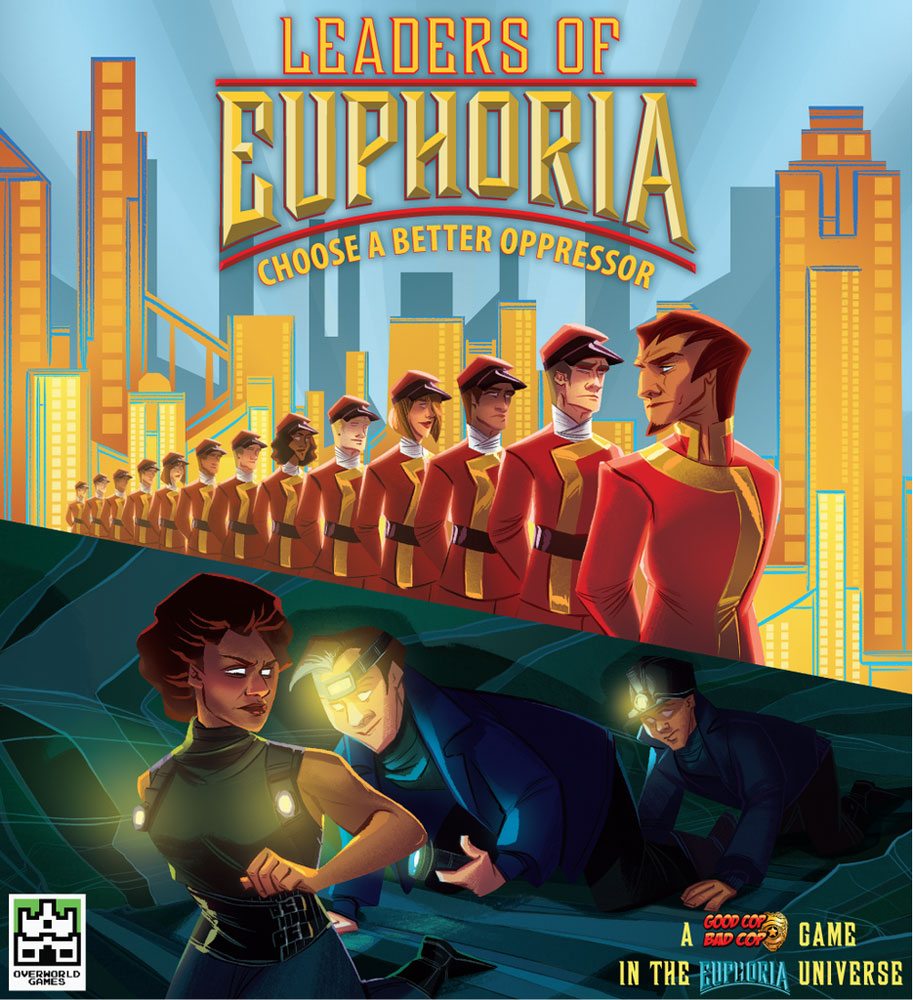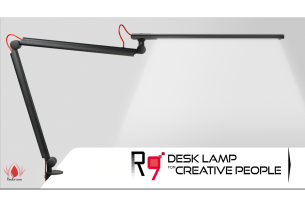In “Reaping the Rewards,” I review the finished product from a Kickstarter campaign. Today’s title is Leaders of Euphoria: Choose a Better Oppressor from Overworld Games, makers of the Good Cop Bad Cop series of games. It was funded on Kickstarter in November 2016, and delivery to backers started in May 2017. It’s now available in stores and online retailers such as Amazon.
At a glance:
Leaders of Euphoria is a hidden-role game for 4 to 8 players, ages 12 and up, and takes 20–30 minutes to play. There are two versions, standard ($21.99 retail) and deluxe ($49.99 retail)—I’ll explain more about the differences below. The game involves hidden roles, bluffing, and shooting ray guns at each other; I’ve let my 10-year-old play and she understands the rules pretty well.

Leaders of Euphoria Components
The standard edition includes:
- 24 Recruit cards (12 each Euphorians and Subterrans, including 1 Leader on each side)
- 24 Artifact cards
- 8 Reference cards
- 4 cardboard Ray Guns
- 1 Interrogator token
The deluxe edition includes:
- 24 Recruit cards (12 each Euphorians and Subterrans, including 1 Leader on each side)
- 24 Artifact cards
- 8 player mats
- 4 plastic Ray Guns
- 1 Interrogator token
The recruits are a mix of genders and ethnicities, which is nice. The artifacts are all various items you’ll recognize from our world, but given different names in this strange dystopian world: a coat rack is a “hunting spear”; the baseball bat is a “stick of encouragement.” I really liked the various items and their unusual dystopian names.
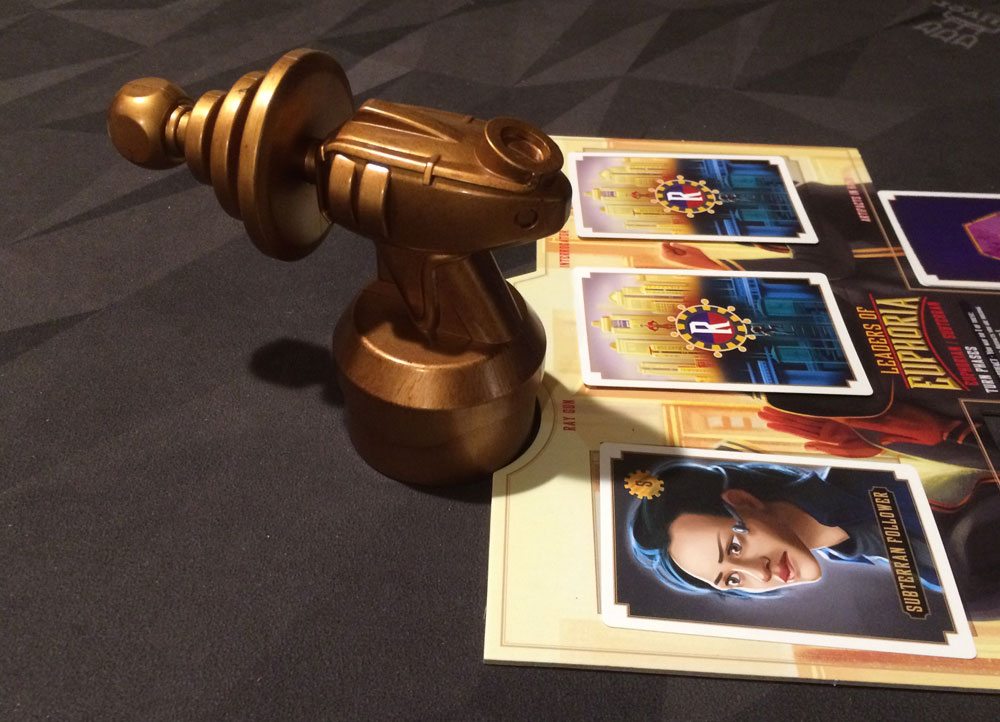
The ray guns look like something out of Buck Rogers: bulbous, with a few discs along the barrel. The standard ray guns are cardboard cut-outs with plastic clips so that you can stand them up on the table and point them in a particular direction. The deluxe ray guns are ridiculously large plastic guns with a metallic gold finish, and they’re very fun to pick up and point and somebody. The only problem is that the base isn’t quite heavy enough: they’ll stand up on their bases, but can also tip over toward the barrel easily if you bump them. I’m considering gluing some washers or something to the bases just to add a little more weight.
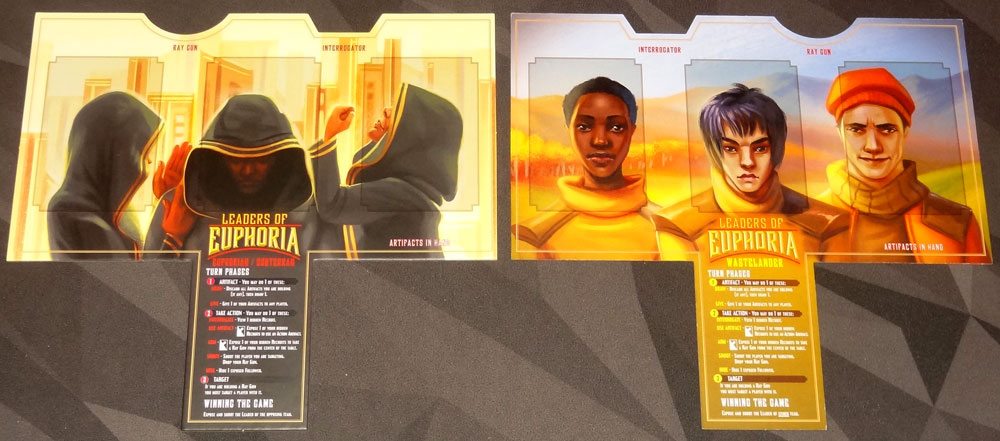
The player mats in the deluxe version look a little like paddles: the board has room for your three recruit cards across the top, with cut-outs for the interrogator token and a ray gun; the “handle” is the reference card. One side shows some hooded figures, and the other shows three Wastelanders.
The illustrations are by Jacqui Davis—I like her style, and the game looks very nice overall.
How to Play Leaders of Euphoria
The goal of the game is to eliminate the leader of the opposing faction, though there are a couple other possible ways to win, too.
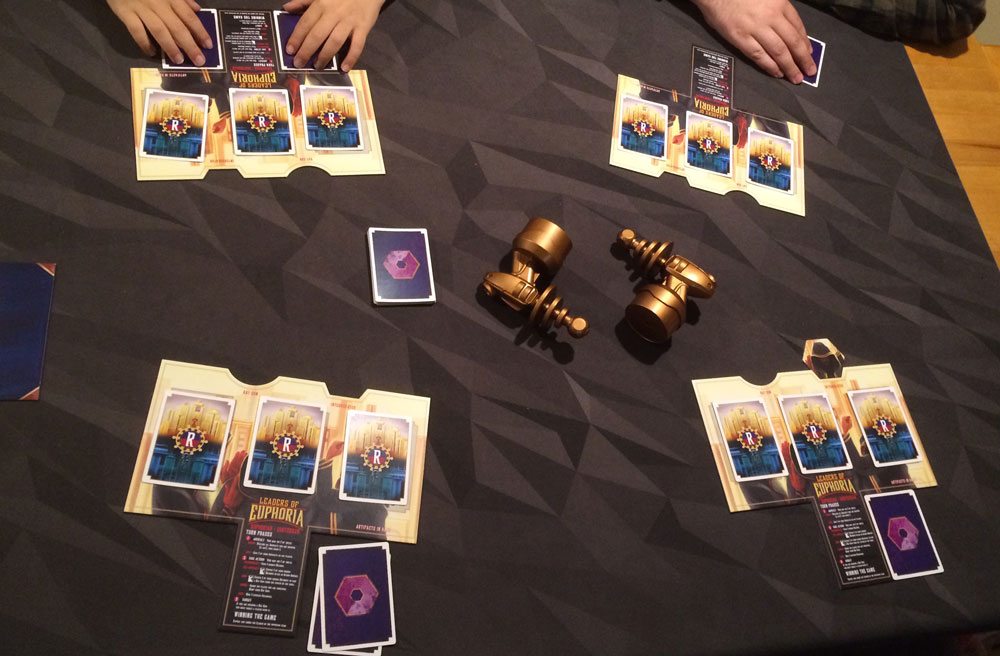
Setup
The recruit cards are marked for the number of players—remove cards for higher numbers of players. Take out both leader cards, shuffle the followers, and then add followers to the leaders so that there’s one recruit card per player. Shuffle these and give one to each player. Then, deal each player two more followers. (This part of the setup is just to ensure that nobody winds up with both leader cards.)
Shuffle and deal each player two artifact cards. Place ray guns in the center of the table—for fewer players, you will remove some ray guns.
Give the starting player the interrogator token.

Your Identity
Each player secretly looks at their three recruit cards, and then places them face-down in front of them. If you have one of the leader cards, then that card determines your faction. Otherwise, you belong to the faction of which you have more cards. You’re allowed to look at your own face-down recruit cards, but you may not rearrange them once placed.
Taking Your Turn
Your turn has three phases: Artifact, Action, Aim.
1. Artifact: you may do 1 of the following:
- Discard all your artifacts and draw a new one
- Give an artifact to another player.
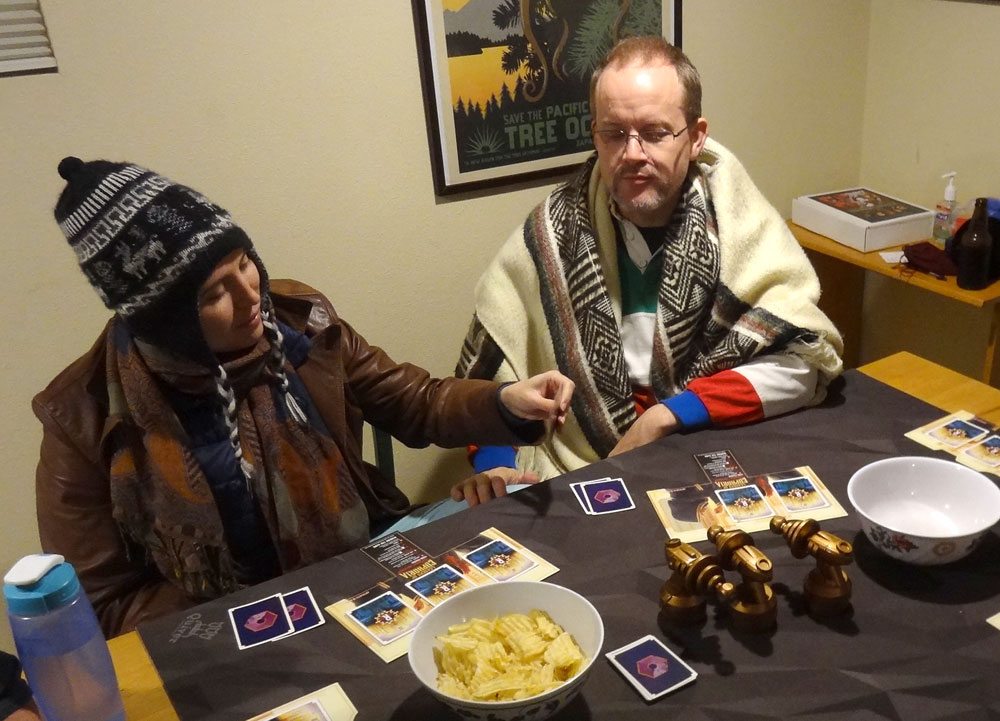
2. Action: you may do 1 of the following:
- Interrogate: Look at any hidden (face-down) recruit belonging to another player.
- Use Artifact: Reveal one of your recruit cards, and use an artifact and then discard it.
- Arm: Reveal one of your recruit cards, and then pick up a ray gun from the table.
- Shoot: Shoot the player your ray gun is targeting, and then return your ray gun to the center of the table.
- Hide: Turn any one exposed (face-up) recruit face-down.
3. Aim: if you have a ray gun, you must aim it at a player.
At the end of your turn, you pass the interrogator token clockwise.
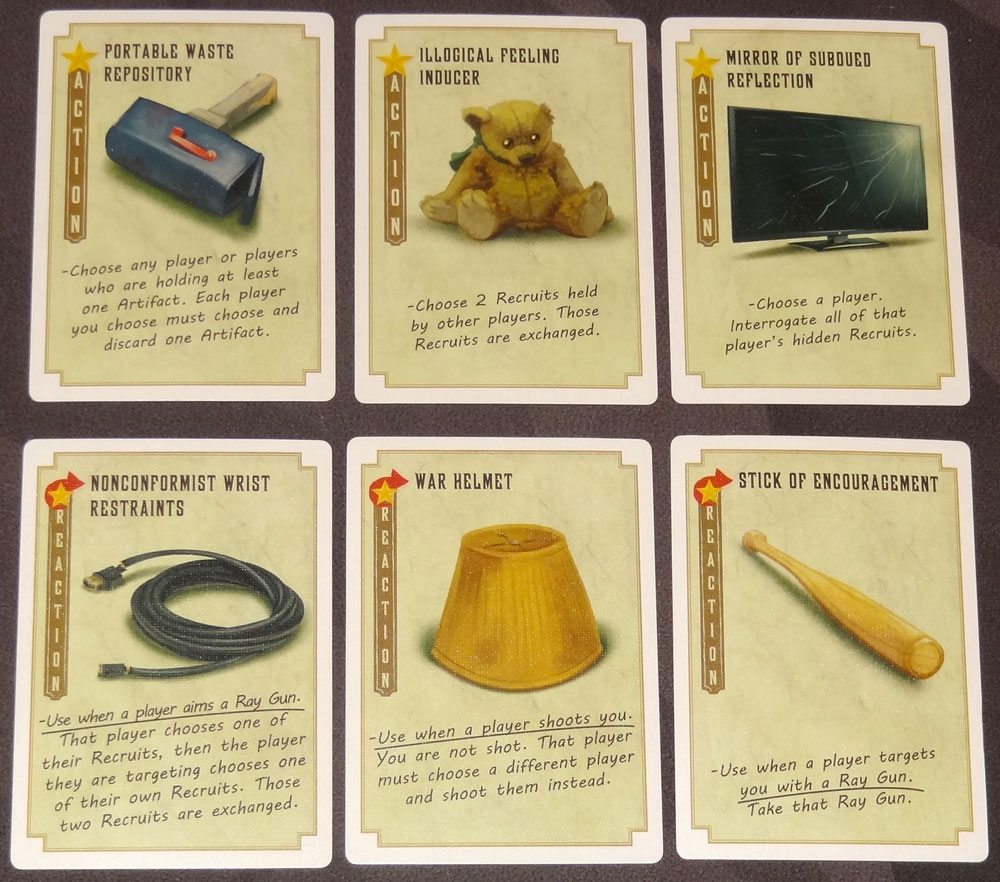
Artifacts
Artifacts can be very powerful, but you must reveal one of your recruits to use them. If you have no hidden recruits, then you can’t use artifacts. Artifacts are marked either as “action” or “reaction.” Action artifacts may only be used on your turn, and count as your action. Reaction artifacts may be used any time that the conditions on the card are met, and they can be played out of turn and do not count as your action—but they still require you to turn a card face-up.
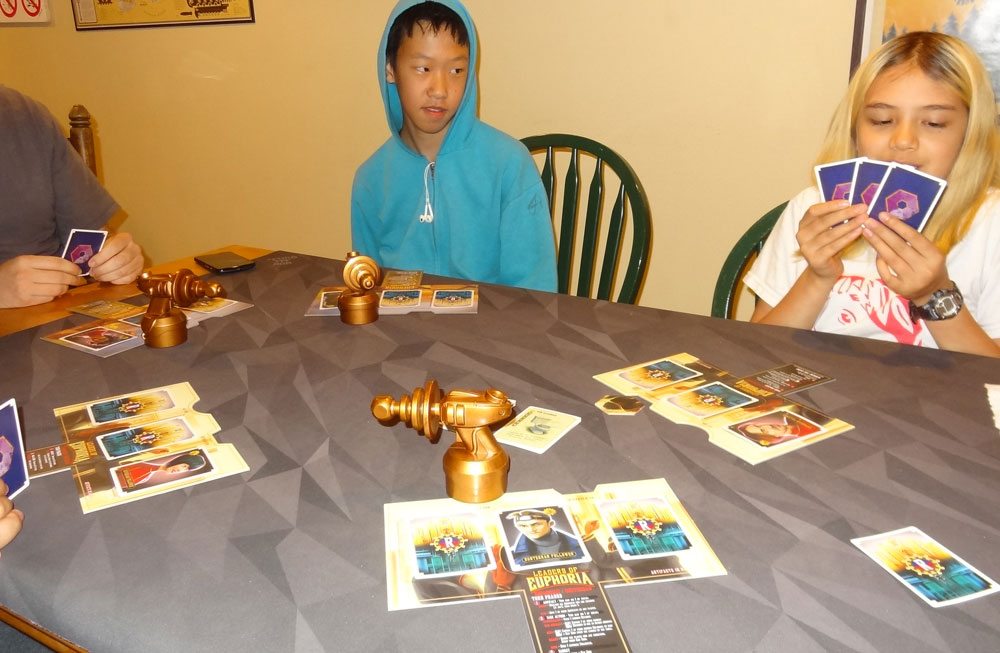
Getting Shot
When a player is shot, there are several possibilities for what happens. If the player did not have an exposed leader card, the game will continue. The shot player exposes all of their recruits, draws an artifact, and drops their ray gun (if any). Then they hide all of their follower recruits, leaving leader recruits exposed. Finally, if they have no leader recruits, they flip their reference card (or player mat) over to indicate that they are now on the Wastelander team.
If the player had an exposed leader card, the game ends immediately. If the player who shot them was a Wastelander, then the Wastelander team wins. Otherwise, the team opposing that leader wins the game.
Other Ways to Win
There are two other ways to win through acquiring leader cards. If you are a Wastelander and you ever manage to acquire a leader card you win alone. Also, if you ever manage to acquire both leader cards, you win alone.
Key Differences From Good Cop Bad Cop
In case you’re familiar with Good Cop Bad Cop, which Leaders of Euphoria is based on, here are the main differences besides the change in theme. First, the “artifact” phase of your turn allows you to get and give artifacts, without revealing any recruit cards. Instead, you only reveal info about your identity when you use an artifact.
The other major difference is that there is no longer player elimination. When you get shot, you reveal all of your identity cards, but then you hide them again (except for a leader card), and if you’re not a leader, you end up on a third team, the Wastelanders, so you still have an opportunity to win.

The Verdict
I had not been a huge fan of social deduction games (like Werewolf/Mafia) for a while—I’d played some back in college but then after I discovered Eurogames I tended to prefer games that didn’t rely as much on the interpersonal relationships between players. It’s easier to figure out numbers and cards than what’s going on in somebody’s head. But one of the games that got me enjoying these games of hidden roles was Good Cop Bad Cop, because I liked the way you could get more information and figure things out for yourself without relying entirely on what other players were telling you. It’s a nice mix of the objective and the subjective—you can lie to hide your identity, or you may be able to hide your identity without ever straying from the truth.
Leaders of Euphoria takes the base Good Cop Bad Cop system and tweaks it just a little in ways that I think make it even better. The biggest change is that there isn’t player elimination, which is handled through the Wastelander faction. Now, when you get shot and you’re not one of the faction leaders, you join a third faction, which means that you’re still a threat. Because of the way Wastelanders can win, even a single Wastelander can put everyone else on edge, because if a leader is exposed, the Wastelander can steal the victory with a well-timed blaster shot.
In one game, I was the Subterran leader, and I found myself with a couple blasters pointed at me. My daughter was a Wastelander, and another friend was still unknown. She had figured out my identity, but knew that if she shot me first, then I would be exposed, and then another (non-Wastelander) player could shoot me and win instead. What she needed was for somebody else to shoot me first, and then she could win—but the other players with guns weren’t Wastelanders, so they knew they didn’t want to give her the victory. Her tactic, then, was to turn her gun on the other player, saying “Zap my dad or I zap you!” It turned out the other player was also a Subterran and had figured me out, so he passed me a protective artifact and then zapped me, keeping me safe from my daughter for at least a round.
The great thing about games like Leaders of Euphoria is that it sets up really fun situations like this. Any time you point a gun at somebody, there’s generally a round of play before you get to zap them, and a lot can happen in that round—somebody might take away your gun, or they might change your mind about who you should be shooting. Or you might shoot anyway, only to discover that you’ve exposed your own leader.
The deluxe version isn’t necessary, but if you like fancy game components, you’ll love the gigantic ray guns—they’re so much more evocative than the chipboard ray guns. But the price difference is purely a component upgrade and doesn’t change the actual gameplay.
The theme may be a little less accessible than Good Cop Bad Cop for those not familiar with Euphoria already, but you don’t really need to know that much: just that it’s some sort of dystopia set in the future where our everyday objects have become valuable artifacts, and that there are (as always) factions vying for supremacy.
The finished game turned out quite nicely, and I’ve enjoyed playing it. I don’t think I’m ready to part with Good Cop Bad Cop just yet (particularly because I have a few of the expansions), but for now, I think Leaders of Euphoria may have the edge, particularly with my kids. (Those giant ray guns!)
Leaders of Euphoria is now available on Amazon and in stores, but Overworld Games announced that the first print run is sold out at the publisher level, which means that if you’re interested you should probably pick it up soon. Or, if you want yet another spin on it, check out Dave Banks’ review of Total Recall, which is currently on Kickstarter—it’s also based on the same mechanics but with its own new twists.
Click here for a full index of our tabletop game reviews.
Disclosure: I received a finished copy of this game for review.

